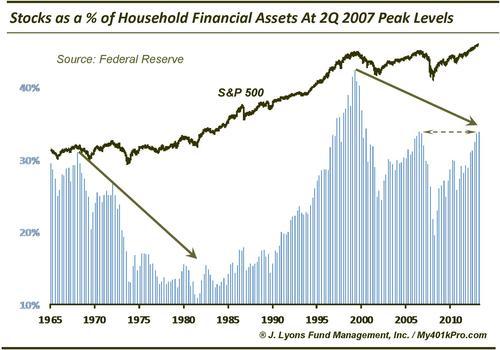ChOTD-6/13/14 Stocks as % of Household Financial Assets At 2Q 2007 Peak Levels
From the Fed’s latest Z.1 Release (formerly Flow of Funds), we get the latest data on one of our favorite charts: the % of Household Financial Assets Invested In Stocks. At 33.9%, the current reading is right at the last cycle’s peak level of 34.0% reached in 2Q, 2007.

The reason we like this series so much is because it so vividly portrays the effects of psychology and human nature on investment behavior. Notice how peak investment occurs at market tops and investment troughs occur at cycle lows. This is not simply a matter of investment positions appreciating/depreciating with the market ups and downs. It is due to the emotional investment reactions induced by the movement of the markets. Investment inflows tend to come after a strong rally has occurred. Conversely, after large declines or long droughts in the market, the heaviest selling occurs.
We have discussed many times how during a secular bear market, investment exposure tends to trend downward, even though the market may generally move sideways. This is due to the frustration on the part of investors unable to make up any ground (likely after buying near the top of the range and forced out again near the bottom.) Case in point, the low % of Household Investment in Stocks during the 1966-82 bear market came right at the end of it in 2Q 1982, even though the market had been some 40% lower earlier.
We believe investment behavior is likely to follow that same pattern if we are still in the secular bear market that started in 2000, which we believe is most likely the case despite the new market highs (yes, we know we are now squarely in the minority there and we understand why. However, we have laid out our reasoning multiple times including in our May newsletter if readers are interested.) While we were somewhat surprised to see the market go to new highs, the behavior of household investment is not surprising. Despite 3 quarters worth of survey data taken while the market was in new high ground, the % investment in stocks is only now up to the levels of the 2007 peak. That would fit with the secular bear market pattern of investment behavior, i.e., although the market is at new highs, household investment is not.
The final act in the secular bear scenario would involve a move to new lows in household investment. Yes, that would imply a very long drought in stocks, a devastating decline or some combination of the two. Yes, that seems unfathomable at this juncture. We don’t believe it is not beyond the realm of possibility.
